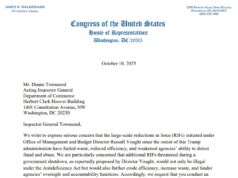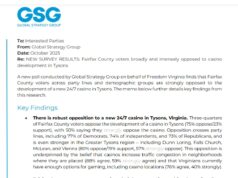(I listened to this program, and yeah, it was extremely lame, particularly on the part of the Warner campaign representative, who simply had nothing interesting to say. – promoted by lowkell)
 Today I attended VPAP’s “After Virginia Votes” panel discussion on the 2014 election featuring senior strategists for both the Warner and Gillespie campaigns. Aside from helping to lower the average age in the mostly octogenarian filled room at George Mason University’s Fairfax campus, I attended to hear how Warner advisor David Hallock would try to spin the near defeat for his boss.
Today I attended VPAP’s “After Virginia Votes” panel discussion on the 2014 election featuring senior strategists for both the Warner and Gillespie campaigns. Aside from helping to lower the average age in the mostly octogenarian filled room at George Mason University’s Fairfax campus, I attended to hear how Warner advisor David Hallock would try to spin the near defeat for his boss.
Sadly, the sometimes candid conversation between David Hallock and Paul Logan paled in comparison to the sparks between Chris LaCivita and Ellen Qualls during VPAP’s 2013 analysis. Now that was an analysis worth attending! LaCivita is an unapologetic political hack, in the most delightful way possible, who never shies away from defending his dirty approach to politics. No wonder many of my friends simply call him “the devil.” Compare that to Logan and Hallock shifting uncomfortably in their seats trying to defend the practice of spamming inboxes in order to raise low donor funds.
Hallock at several times made the point that the lack of engagement during the midyear election depressed both volunteer enthusiasm and eventual voter participation, particularly among the Democratic base. While bemoaning the difficulties of getting Democratic constituencies to the poles, he clung to defending Warner’s “statewide” campaign that stressed bipartisanship and reaching out to Southwest and Southside Virginia.
Perhaps Democratic disengagement is not a fact of life for midterm elections, but a byproduct of the type of campaign Warner ran?
In his concluding remarks, Hallock made the case that the Democratic Party needs to do a better job of engaging our voters and turning them out in off-year elections.
Let’s talk about that.
First, I was surprised by Hallock’s claim that Warner ran eight to ten points ahead of Democratic performance in parts of Southwest and Southside Virginia. At first, believing maybe he meant lower turnout years like 2013, I made sure to pay attention when he specifically mentioned Tim Kaine’s Senate campaign as a comparison.
Consider the historic coal country counties of Southwest Virginia that were once a bedrock of Democratic support (Check out Kenton’s excellent analysis of Southwest Virginia.)
Southwest Virginia Counties
Tazewell County-
Warner 2014: 26.6%
Obama 2012: 20.6%
Kaine 2012: 24.2%
Russell County-
Warner 2014: 37.6%
Obama 2012: 30.8%
Kaine 2012: 35.5%
Scott County-
Warner 2014: 27.1%
Obama 2012: 24.0%
Kaine 2012: 28.0%
Buchanan County-
Warner 2014: 38.7%
Obama 2012: 32.1%
Kaine 2012: 35.7%
Dickenson County-
Warner 2014: 41.9%
Obama 2012: 35.8%
Kaine 2012: 40.5%
Wise County-
Warner 2014: 28.2%
Obama 2012: 25.0%
Kaine 2012: 28.7%
Lee County-
Warner 2014: 34.9%
Obama 2012: 26.9%
Kaine 2012: 30.4%
This is not a story of Warner running eight to ten points ahead of Tim Kaine. This is at most running 4.5 percentage points ahead in one county; for the most part Warner was right around the same range as Kaine. And while Warner was ahead of Obama in some areas, it’s a lower range than Hallock’s eight to ten claim would lead you to believe.
So much for Warner’s immense appeal in Southwest Virginia, what about Southside? I pulled a handful of localities just to look:
Pittsylvania County-
Warner 2014: 36.2%
Obama 2012: 35.4%
Kaine 2012: 36.1%
Danville City-
Warner 2014: 57.9%
Obama 2012: 60.5%
Kaine 2012: 59.9%
Halifax County-
Warner 2014: 46.2%
Obama 2012: 46.5%
Kaine 2012: 46.2%
Charlotte County-
Warner 2014: 40.9%
Obama 2012: 42.4%
Kaine 2012: 42.8%
Mecklenburg County-
Warner 2014: 42.0%
Obama 2012: 45.9%
Kaine 2012: 44.1%
Lunenburg County-
Warner 2014: 40.9%
Obama 2012: 46.8%
Kaine 2012: 46.6%
Warner didn’t just fail to run eight to ten points ahead of Democrats in Southside Virginia, you can’t even see a trend of him doing better at all than Barack Obama and Tim Kaine.
I don’t have time to run the numbers for the entire state, but once the dust settles, the Warner campaign’s claims of running significantly ahead of Democrats in rural Virginia will come under question and be found lacking in support.
An easier way to look at this is to check the results in the Congressional districts (I’m using VPAP’s percentages for Congressional districts, which are preliminary).
1st-
Warner 2014: 42.0%
Obama 2012: 45.5%
Kaine: 2012: 41.2%
2nd-
Warner 2014: 47.9%
Obama 2012: 50.0%
Kaine: 2012: 52.0%
3rd-
Warner 2014: 76.8%
Obama 2012: 78.8%
Kaine: 2012: 79.2%
4th-
Warner 2014: 46.6%
Obama 2012: 48.7%
Kaine: 2012: 50.0%
5th-
Warner 2014: 43.6%
Obama 2012: 45.8%
Kaine: 2012: 47.0%
6th-
Warner 2014: 37.1%
Obama 2012: 39.4%
Kaine: 2012: 40.9%
7th-
Warner 2014: 40.8%
Obama 2012: 41.6%
Kaine: 2012: 44.7%
8th-
Warner 2014: 66.7%
Obama 2012: 67.6%
Kaine: 2012: 69.3%
9th-
Warner 2014: 37.8%
Obama 2012: 34.8%
Kaine: 2012: 38.1%
10th-
Warner 2014: 46.1%
Obama 2012: 48.7%
Kaine: 2012: 50.4%
11th-
Warner 2014: 59.1%
Obama 2012: 62.3%
Kaine: 2012: 63.6%
Warner ran behind Obama in every district but one, the 9th District. Other western and southern Virginia districts with significant rural populations, such as the 4th, 5th, and 6th, still had Warner running behind Obama like in the rest of the state.
If I see any trend, it’s that Warner ran behind Obama by the same two points in almost all Congressional districts, except for three points behind in the 11th and 1st, but only a point behind in the 7th and 8th. During the VPAP discussion, Hallock said the energy and enthusiasm behind Brat lifted turnout in the 7th district and hurt the Warner campaign there, but it also seems to have minimized his drop-off from Obama by giving die-hard Democrats in the ruby-red district a reason to vote.
The Warner campaign wants us to believe that it couldn’t afford to talk up the Democratic Party and its accomplishments because it needed to pad its margins in rural Virginia. I don’t see the padding.
What lessons can we learn from 2014? Well that’s something I wish the DPVA would have a candid and frank discussion on. They clearly aren’t going to do that, so comment below with your thoughts.













